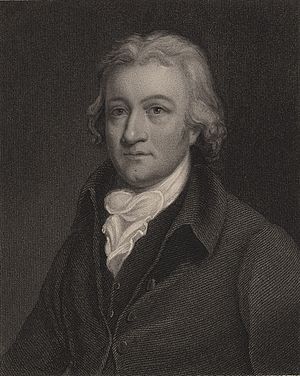Edmund Cartwright facts for kids
Quick facts for kids
Edmund Cartwright
|
|
|---|---|

Edmund Cartwright
|
|
| Born | 24 April 1743 Marnham, Nottinghamshire, England
|
| Died | 30 October 1823 (aged 80) |
| Resting place | Battle, Sussex |
| Nationality | English |
| Education | Oxford University |
| Occupation | Clergyman, inventor |
| Known for | Power loom |
| Signature | |
Edmund Cartwright (born April 24, 1743 – died October 30, 1823) was an English inventor. He studied at Oxford University. He is best known for inventing the power loom, a machine that made weaving much faster. At 19, he married Elizabeth McMac. His brother, Major John Cartwright, was a political reformer. Another brother, George Cartwright, was an explorer.
Early Life and Education
Edmund Cartwright went to Queen Elizabeth Grammar School, Wakefield. He then studied at University College, Oxford and Magdalen College, Oxford. He earned a Master of Arts degree in 1766. Later, he became a clergyman in the Church of England.
In 1779, he became the rector of Goadby Marwood, Leicestershire. He also became a prebendary at Lincoln Cathedral in 1783. Even though he was a clergyman, he also wrote poems. He published Armine and Elvira in 1770. He also wrote The Prince of Peace in 1779. In 1806, he received a Doctor of Divinity degree. For a time, he worked for the Duke of Bedford. He also taught the Duke's son, Lord John Russell.
The Power Loom
Edmund Cartwright created his first power loom design in 1784. He received a patent for it in 1785. However, this first version was not very useful. In 1789, he patented a new loom. This design became a base for other inventors to improve upon. For a machine-driven loom to be successful, one person needed to operate many machines. Or, each machine had to produce much more than a hand loom.
Cartwright kept adding new features to his loom. He added ways to control the fabric and stop the machine if threads broke. He also found a way to prepare the threads while the loom was working. He started a factory in Doncaster to make fabrics using his looms. Here, he found many problems with his machines. He tried to fix these issues. For example, he improved how the shuttle moved. He also added devices to stop the loom if the shuttle did not work right. But his factory was taken over by people he owed money to in 1793.
In 1792, Cartwright got his last patent for weaving machines. This patent allowed his loom to weave patterns like checks and stripes. But his efforts were still not fully successful. The main problem was preparing the threads (called warps) before weaving. This issue was solved in 1803 by William Radcliffe and Thomas Johnson. They invented machines to prepare the warps better.
In 1790, a man named Robert Grimshaw built a factory in Manchester. He planned to use 500 of Cartwright's power looms. But after only 30 looms were installed, the factory was burned down. This was likely done on purpose by weavers who feared losing their jobs to machines. Because of this, the factory was not rebuilt.
In 1809, the British government gave Cartwright £10,000. This was a large sum of money for his invention. In May 1821, he became a Fellow of the Royal Society. This was a great honor for his scientific work.
Other Inventions
Cartwright also invented other machines. In 1789, he patented a machine for combing wool. This machine helped prepare wool for spinning. In 1792, he invented a "cordelier." This machine was used for making rope. He also designed a steam engine that could run on alcohol instead of water.
Family Life
After receiving the money from parliament, Cartwright bought a small farm in Kent. He lived there for the rest of his life. Edmund Cartwright passed away in Sussex after a long illness. He was buried in Battle.
His daughter, Elizabeth (1780–1837), married the Reverend John Penrose. She became a writer and published books under the name Mrs Markham.
See also
 In Spanish: Edmund Cartwright para niños
In Spanish: Edmund Cartwright para niños
- Timeline of clothing and textiles technology


